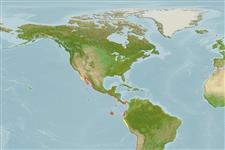Environment: milieu / climate zone / depth range / distribution range
Ökologie
seewasser riff-verbunden; tiefenbereich 21 - 40 m (Ref. 5222). Subtropical; 33°N - 13°S, 118°W - 76°W (Ref. 5222)
Eastern Pacific: southern California, USA to Peru, including Revillagigedo and Galapagos Islands, Cocos Island, Clipperton Island.
Size / Gewicht / Alter
Maturity: Lm ? range ? - ? cm
Max length : 100.0 cm TL Männchen/unbestimmt; (Ref. 5222); max. veröff. Gewicht: 12.5 kg (Ref. 4699)
Rückenflossenstacheln (insgesamt): 11; Rückenflossenweichstrahlen (insgesamt): 18-20; Afterflossenstacheln 3; Afterflossenweichstrahlen: 9. Distinguished by the following characteristics: body depth, 2.1-2.5 in SL; dorsal profile of head is steep; eye diameter less than snout length, 5.2-8.0 in HL; short pectoral fins, length 18-26% of SL; rounded caudal fin; smooth scales, mostly covered by skin; lateral line scales 62-67 (Ref. 089707).
A diurnal predator that feeds on small benthic fishes and occasionally on crustaceans. Often it uses browsing herbivorous fishes as a moving blind in order to feed on the cryptic fauna disturbed by these browsers; it will also follow foraging moray eels to catch the fishes frightened from their hiding places. Small juveniles have been seen hiding among the long spines of the dark-colored sea urchin, Centrostephanus coronatus.
Life cycle and mating behavior
Geschlechtsreife | Fortpflanzung | Ablaichen | Eier | Fecundity | Larven
Heemstra, P.C. and J.E. Randall, 1993. FAO Species Catalogue. Vol. 16. Groupers of the world (family Serranidae, subfamily Epinephelinae). An annotated and illustrated catalogue of the grouper, rockcod, hind, coral grouper and lyretail species known to date. Rome: FAO. FAO Fish. Synop. 125(16):382 p. (Ref. 5222)
IUCN Rote Liste Status (Ref. 130435)
Bedrohung für Menschen
Harmless
Nutzung durch Menschen
Fischereien: weniger kommerziell; Sportfisch: ja
Mehr Information
ReferenzenAquakulturAquakultur ProfilZuchtlinienGenetikElectrophoresesVererbbarkeitKrankheitenVerarbeitungNutrientsMass conversion
PartnerBilderStamps, Coins Misc.LauteCiguateraGeschwindigkeitSchwimmstilKiemenoberflächeOtolithsGehirngrößeSehfähigkeit
Tools
Zusatzinformationen
Download XML
Internet Quellen
Estimates based on models
Preferred temperature (Ref.
123201): 23 - 26.3, mean 24.6 °C (based on 7 cells).
Phylogenetic diversity index (Ref.
82804): PD
50 = 0.6250 [Uniqueness, from 0.5 = low to 2.0 = high].
Bayesian length-weight: a=0.01148 (0.00558 - 0.02364), b=3.04 (2.88 - 3.20), in cm total length, based on LWR estimates for this (Sub)family-body shape (Ref.
93245).
Trophic level (Ref.
69278): 4.5 ±0.80 se; based on food items.
Widerstandsfähigkeit (Ref.
120179): niedrig, Verdopplung der Population dauert 4,5 - 14 Jahre. (Preliminary K or Fecundity.).
Fishing Vulnerability (Ref.
59153): High vulnerability (60 of 100).
Nutrients (Ref.
124155): Calcium = 13.4 [7.5, 27.8] mg/100g; Iron = 0.458 [0.229, 0.802] mg/100g; Protein = 19.5 [17.6, 21.1] %; Omega3 = 0.193 [0.111, 0.339] g/100g; Selenium = 16.7 [7.6, 35.5] μg/100g; VitaminA = 71.9 [22.3, 259.5] μg/100g; Zinc = 0.509 [0.328, 0.786] mg/100g (wet weight);
